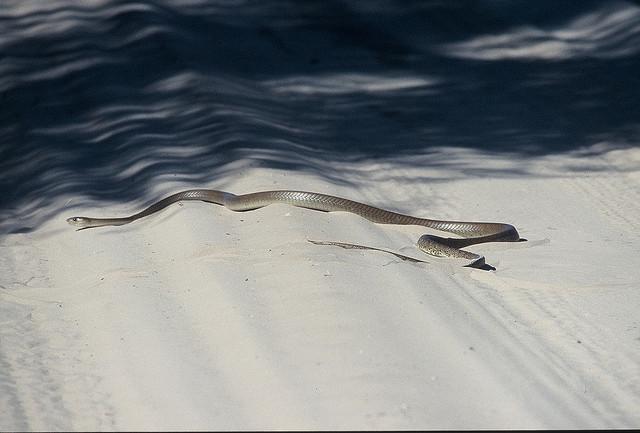
Home of Dendroaspis polylepis
The black mamba is one of the most feared snakes in the
world if not number one, and for good reason. The scientific
name of the black mamba is Dendroaspis polylepis, which is part
of its classification. The name is
derived from many Latin words that have been combined. “Dendro”
is derived from a word meaning tree, because many of the snakes
in that genus are tree snakes, “aspis” comes from a word meaning
shield which is used to describe a snake coiling itself, “poly”
can be translated as many, and “lepis” is derived from a word
meaning scales. So in English, Dendroaspis polylepis means
tree snake with many scales. It is the longest venomous snake in
Africa (its habitat), reaching lengths of
nearly 14 feet. Despite what their name suggests however, they are
not black in color. Their bodies are brown. Their name comes from the inside of
their mouth, which is a striking black in color, the last thing
its prey (read more in Nutrition) sees before it is injected with its deadly
venom. They
don’t like to use their venom however, as they are a very timid snake.
When confronted by a disruption, their first instinct is to
flee to protection. They have many
interactions with other animals, but
don't use their venom unless they have to.

Photo Courtesy of frederic.salein,
http://www.flickr.com/photos/fredericsalein/2921203818/
They can become very aggressive however,
when they are cornered and given no place to escape to. They
will make themselves appear larger by raising their head and
body off the ground and expanding their necks in a morphological
shape reminiscent of the cobras (one of its many cool
adaptations). When threatened, they are not
afraid to strike multiple times, utilizing their extremely
potent venom. They reproduce
sexually using amniotic eggs, which is an interesting strategy.
You can learn more interesting things about the black mamba on the
facts page. The Black Mamba is a very compelling organism,
and there is much more to learn!
This webpage is part of a larger project combining many different
organisms at
MutipleOrganisms.net
To visit the reference page, click here